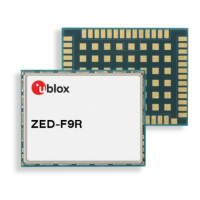ZED-F9R-Integration manual
3.11.5.3 Receiver configuration lock
The receiver configuration lock feature ensures that no configuration changes are possible once the
feature is enabled. The configuration lock is enabled by setting the configuration item CFG-SEC-
CFG_LOCK to "true".
The configuration lock can be applied to different configuration layers including the RAM, BBR,
and flash memory. At startup, the receiver constructs the configuration database from different
configuration layers and maintains it in the run-time RAM memory. When the configuration lock is
set in the run-time RAM, the receiver configuration cannot be changed on any configuration layer.
For more information on the configuration layers including the order of priority they are
applied in, see the applicable interface description [2].
The configuration lock set on a configuration layer in volatile memory (RAM, BBR) is removed when
the memory is cleared. However, the configuration lock set in non-volatile memory (flash memory)
is permanent apart from one exception: during firmware upload to flash memory, the flash is erased
during the process causing the configuration lock to be cleared. Refer to Firmware upload for more
information on firmware update.
To test the lock functionality, set it on the RAM configuration layer. After a power cycle, the
information on RAM layer is cleared and the lock is no longer set.
It is recommended to apply the configuration lock on the same layer the configuration is
stored.
An example of use case is that the host application locks the receiver configuration. A user
communicating with the ZED-F9R through any of the available interfaces can poll, enable or send
messages, but cannot change the configuration by sending UBX configuration messages.
3.12 u-blox protocol feature descriptions
3.12.1 Broadcast navigation data
This section describes the data reported via UBX-RXM-SFRBX.
UBX-RXM-SFRBX reports the broadcast navigation data message the receiver has collected from
each tracked signal. When enabled, a separate message is generated each time the receiver decodes
a complete subframe of data from a tracked signal. The data bits are reported as received, including
preambles and error checking bits as appropriate. However, because there is considerable variation
in the data structure of the different GNSS signals, the form of the reported data also varies. This
document uses the term "subframe", but other GNSS data structures might use different terms, for
example, GLONASS uses "strings" and Galileo uses "pages".
3.12.1.1 Parsing navigation data subframes
Each UBX-RXM-SFRBX message contains a subframe of data bits appropriate for the relevant
GNSS, delivered in a number of 32-bit words, as indicated by numWords field.
Due to the variation in data structure between different GNSS, the most important step in parsing
a UBX-RXM-SFRBX message is to identify the form of the data. This should be done by reading the
gnssId field, which indicates which GNSS the data was decoded from. In almost all cases, this is
sufficient to indicate the structure. Because of this, the following sections are organized by GNSS.
However, in some cases the identity of the GNSS is not sufficient, and this is described, where
appropriate, in the following sections.
UBX-20039643 - R06
3 Receiver functionality Page 77 of 119
C1-Public

